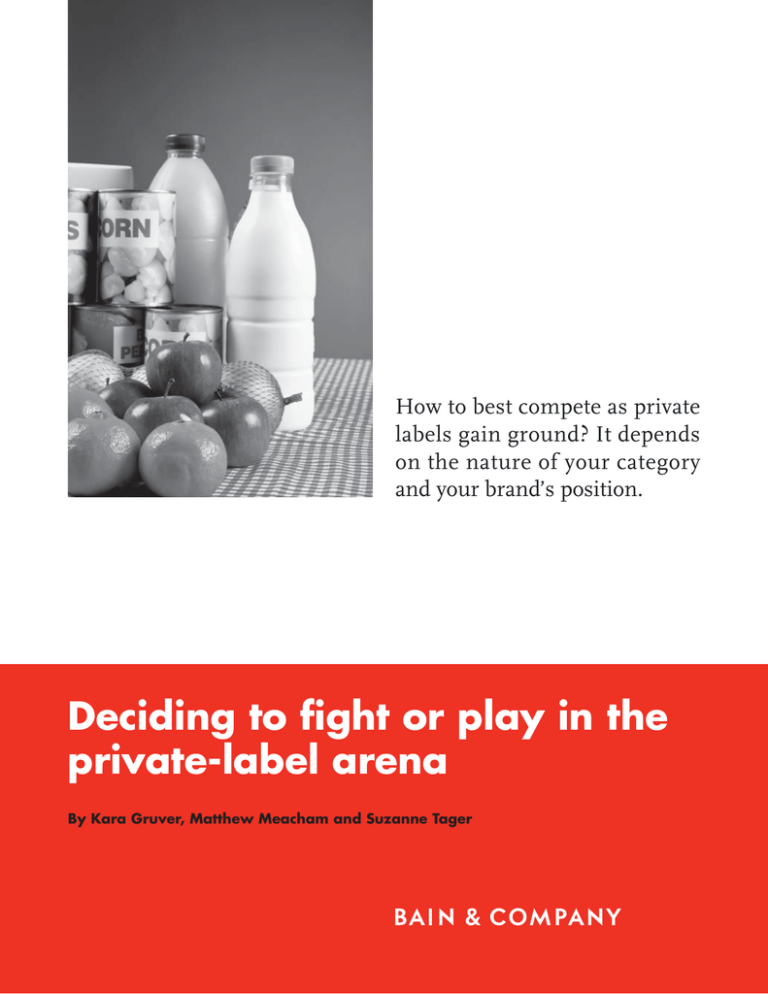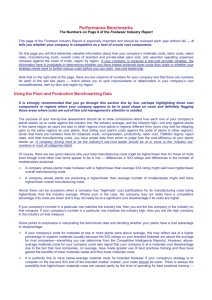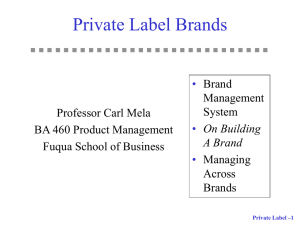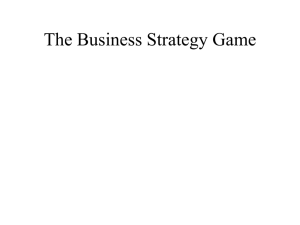
How to best compete as private
labels gain ground? It depends
on the nature of your category
and your brand’s position.
Deciding to fight or play in the
private-label arena
By Kara Gruver, Matthew Meacham and Suzanne Tager
Kara Gruver is a Bain & Company partner based in Boston and leads the firm’s
Americas Consumer Products practice. Matthew Meacham, a partner in Madrid,
leads Bain’s Consumer Products practice in Europe. Suzanne Tager is senior
director of Bain’s Americas Consumer Products and Retail practices and is
based in New York.
Copyright © 2011 Bain & Company, Inc. All rights reserved.
Content: Editorial team
Layout: Global Design
Deciding to fight or play in the private-label arena
How to best compete
as private labels gain
ground? It depends
on the nature of your
category and your
brand’s position.
share declined over the past four years, while
the category grew. Danone alone introduced
nine new products to gain four points of share
between 2006 and 2010, even while raising prices.
But successful as it can be, innovation requires
relentless focus and consistent investment.
Look at what happened with Tylenol. Once the
brand’s innovation cycle slowed to a point
We’ve all seen the headlines about private labels:
where it had no new innovations in six years,
retailers all over the world are increasing their
private labels gained ground; penetration in-
investment in owned brands, and consumers
creased from 14 percent in 1991 to 42 percent
are routinely buying them. Even before the recent
in 2010.
recession hit, private labels’ mounting success in
many regions provided evidence that the growth
While some brands have won by fighting private
of these brands was no longer a cyclical reaction
labels, others have found success in joining the
to economic downturns, but instead a structural
private-label pack. For example, Kimberly-Clark
change in the consumer products landscape
makes private-label products such as diapers
(see sidebar, “How big are private labels
to improve asset utilization, particularly with
getting?”). But even as the power shifts and
older technology. The company has also found
competition gets tougher, the outcome is not
the added benefit of securing exclusive shelf
as gloomy as many have predicted; branded
placement with important retailers like Costco,
players can have a significant impact on the
where it has been the exclusive brand in the
trajectory of private labels. The first step is to
diaper category for the past five years. It can
make choices: how much to invest to defend
accomplish that because some of its private-
against the onslaught and how and when to
label and branded products are relatively similar,
manufacture private-label products.
allowing it to take advantage of purchasing,
distribution and manufacturing synergies. In
Tylenol®, a leader in pain relievers, chose the
Germany, some branded players have followed
defensive strategy. Historically, the brand fore-
a similar strategy when hoping to list with Aldi,
stalled private labels in the US by launching
a retailer that carries few brands but garners
new products roughly every two years in the
nearly 15 percent of the grocery market. In the
1980s and early 1990s, riding a wave of inno-
UK, a local player in the biscuits and cereal
vation that delivered double-digit revenue growth
category has found that manufacturing private-
on the success of such product extensions as
label products helps build scale to compete
gelcaps, Children’s Tylenol and Tylenol PM.
against global players.
Branded players in the yogurt category recently
used the same strategy. In fact, their focus on
Of course, building scale with private-label
innovation has made yogurt the only category
manufacturing also comes with risks, as not
among the top 30 we studied where private-label
all scale is the same. By nature, private labels
1
Deciding to fight or play in the private-label arena
add short-run manufacturing complexity. Sales
So how does one decide how much to invest and
team demands increase as most retailers have
whether to join private labels? We’ve found that
separate buying teams for branded and private-
the High Road-Low Road framework we detail
label products, and retailers often demand
in High Road-Low Road, revisited is a useful tool.
innovation to flow into private-label products
A brand’s reaction to private-label threats should
quickly—increasing innovation cycles and
take into account the nature of the category in
likely reducing margins. Also, companies must
which it plays and its position in that category.
manage to a “cost culture,” aiming for continuous improvements to stay competitive. That
For example, in premium categories, it rarely
is no small task side by side with a branded
makes sense to enter the private-label arena
culture. Those are reasons that contributed to
(see Figure 1). Leaders should steward cate-
Birds Eye’s decision to exit the private-label
gory innovation and build brand equity, while
business in 2006 and pursue opportunities to
followers should focus on finding a consumer
grow its branded products.
segment or usage occasion that the leader is
Figure 1: Category “premiumness” and market position guide private-label entrance strategy
Category
“premiumness”
High
Low
Grow away from private label
Consider opportunistic entry
(particularly if a value player)
Avoid
(except in rare occasions)
• Ex.: KimberlyClark
• Use to gain customer leverage and
shut out competitors
• For value brands, use private labels
as a means to gain scale
• Only consider opportunities that offer
increased geographic or channel penetration
• Manufacturing and supply chain
synergies must be extremely high
Analyze all opportunities
(particularly if a value player)
Explore only if privatelabel share is very high
(or propensity exists)
• Ex.: American Italian Pasta Company
• Use to increase scale and improve
cost structure
• Ex.: Candia
• Tap a large segment of the market
and defend scale advantages
Target privatelabel share
Follower
Leader
Relative market share
Critical analyses
• CAPEX and OPEX ROI
• Manufacturing and
distribution utilization
• Full system complexity
• Innovation strategy
2
•
•
•
•
Management bandwidth
Corporate culture complexity
Brand equity risk
Competitive dynamics and
scenario outcomes
Deciding to fight or play in the private-label arena
How big are private labels getting?
In Western Europe and the US, private-label products accounted for nearly all of the growth
in packaged food, beauty and personal-care, and home-care categories from 2000 to 2010.
The global recession gave private labels an added boost, and in many categories the gains
were sticky. Of 30 top US categories we analyzed recently, there was only one—yogurt—in
which private labels lost share while brands grew in the years 2006 to 2010. Private label’s
share of new product introductions has steadily increased in every region of the world since
2005. Sainsbury’s in the UK launched 1,300 new own-brand products and improved a further
3,500 in 2010. Carrefour innovated to introduce no fewer than 2,000 private-label products
in 2009. Kroger’s private-label products account for 35 percent of grocery units sold and 27
percent of dollar sales. Even in markets where private labels traditionally have had a lower
profile, retailers are getting into the act—everyone from Korea’s E Mart to Brazil’s Pão de
Açúcar. Many of these products are higher quality than the generics of yore, offer health,
convenience or other benefits, and scan at low prices.
In retrospect, the rise of store brands is not surprising. Store brands help retailers differentiate
themselves from competitors and often provide superior economics—an extra eight to 10
points of gross margin is typical in many categories. And retailers have grown big enough
to invest in the insights and capabilities needed to build their own brands. There is a clear link
between organized retail consolidation and private-label penetration: in Switzerland, the
top five retailers have more than 70 percent share—and private labels have approximately
45 percent penetration. In France, top retailers account for more than 60 percent of sales;
private labels have more than 30 percent penetration. By comparison, Russia’s relatively low
rate of consolidation—around 20 percent—translates to less than 5 percent private-label
penetration. Bain analysis has found that for every 10 point increase in retailer consolidation,
private-label penetration rises by approximately three points.
Private-label gains have been most acute in premium categories. (We define “premiumness”
as the percentage of a category sold at a premium to value or private-label offerings.) Bain
analysis shows premium categories, such as refrigerated grape juice and graham crackers,
experienced more dramatic private-label growth during the recession than value categories,
such as canned beans and condensed soup. After the recession, brands in premium categories
have clawed back share more successfully than brands in value categories. But in nearly twothirds of the premium categories we examined, private-label products sustained or continued
to gain share.
Even in markets where private-label penetration is currently low, consumers are increasingly
willing to incorporate private-label products into their shopping repertoire. In Singapore,
while only 56 percent of households tried private labels in 2004, more than 90 percent did
four years later.
The signals are clear: no geography or category is immune to the increasing—and enduring—
competition of private labels.
3
Deciding to fight or play in the private-label arena
under-serving, and use differentiated innovation
year), whose brands include Heartland and
and brand building to target that subsegment.
Mueller’s, manufactures private-label products
Strengthening the value tier dilutes manage-
for most major US grocers and club stores as
ment focus and fortifies the base of the category
a major source of growth in the dry pasta cate-
pyramid. There are situations—Kimberly-Clark
gory. Today, it is North America’s largest pro-
is an example—where the opportunity to access
ducer of dry pasta. Yet even for these brands,
a new channel or create purchasing, distribution
joining private labels requires caution—and
and manufacturing synergies presents a com-
the need to carefully monitor such metrics as
pelling economic rationale. But these are rare.
return on invested capital as well as manufac-
The best defense is to play offense: innovate
turing and distribution utilization.
and reinforce consumers’ emotional connections to brands.
Before deciding which way to go, consumer
products executives need to fully understand
In value categories, the game is completely
category characteristics, the options for defend-
different. Defending against private labels
ing against private-label growth and the eco-
requires a focus on cost position, managing
nomic scenarios of private-label participation
price gaps and plowing excess returns into
by any of the leading players in a particular
communication and innovation around bene-
category. Only then can they make the right
fits. Runaway leaders have little incentive to
moves in a game that has undeniably changed—
manufacture private labels because they already
and has become too big to ignore.
have scale advantage. But close rivals or follower
brands can use private labels to tip the balance
in their favor, particularly if private label has
high share or if the category has a propensity
for private-label growth (see sidebar, “What
makes a category prone to higher private-label
penetration?”). The French dairy Candia entered private-label milk and generated scale cost
savings that were invested to develop highmargin, value-added milk products. That strategy
allowed the company to remain the branded
market leader in milk. American Italian Pasta
Company (acquired by Ralcorp Holdings last
4
What makes a category prone to higher private-label penetration?
For branded players in markets or categories with low rates of private-label penetration,
understanding the threat of private labels starts by analyzing the characteristics that make it
more likely for those products to gain a foothold. Bain analysis found 10 characteristics that
explain the differences in private-label penetration across categories. Some of these characteristics reflect the nature of the product. For example, perishable goods more often attract
private-label competitors than non-perishable goods. But many of the characteristics are within
a brand’s control. The higher the levels of innovation or media spend in a category, the lower
the private-label penetration. Such considerations are invaluable in determining private-label
strategies: where to play and how to win.
10 category characteristics are related to private-label penetration
Higher
privatelabel
penetration
28%
Highly fragmented
35%
Low
30%
Infrequent
30%
Low
19%
Warehouse
32%
Narrow
28%
Low
24%
Frequent
31%
Single/standardized
32%
Perishable
Category consolidation
Highly consolidated
6%
High
14%
Frequent
8%
High
11%
Direct store delivery (DSD)
12%
Broad
5%
High
6%
Infrequent
16%
Multiple/complex
6%
Nonperishable
18%
Barriers to entry
Innovation
Media spend
Distribution approach
Product line breadth
Perceived consumer risk
Purchase frequency
Active ingredients
Perishable
Source: Bain analysis, based on FDMx (Food, Drug, Mass excluding WalMart) markets
Lower
privatelabel
penetration
Bain’s business is helping make companies more valuable.
Founded in 1973 on the principle that consultants must measure their success in terms
of their clients’ financial results, Bain works with top management teams to beat competitors
and generate substantial, lasting financial impact. Our clients have historically outperformed
the stock market by 4:1.
Who we work with
Our clients are typically bold, ambitious business leaders. They have the talent, the will
and the open-mindedness required to succeed. They are not satisfied with the status quo.
What we do
We help companies find where to make their money, make more of it faster and sustain
its growth longer. We help management make the big decisions: on strategy, operations,
technology, mergers and acquisitions and organization. Where appropriate, we work with
them to make it happen.
How we do it
We realize that helping an organization change requires more than just a recommendation.
So we try to put ourselves in our clients’ shoes and focus on practical actions.
For more information, please visit www.bain.com








